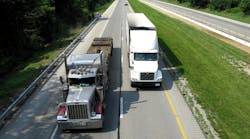I was reading the most recent edition of the ATRInsider, a newsletter published by the American Transportation Research Institute. One of the articles talked about the six priority research topics for 2019 as determined by ATRI’s Research Advisory Committee.
These priorities include standardizing truck parking information systems, re-thinking mileage-based safety metrics, analyzing younger driver safety in intrastate driving, revising the ROI of truck safety technologies, impact of ‘nuclear’ verdicts on trucking and a comparative analysis of toll revenue reinvestment.
Notice how many of these are focused on safety? I am especially interested to see the research on the cost-benefit analysis of the advanced safety technologies that are being deployed today.
Some fleets are shying away from some of these new systems including lane departure warning and collision avoidance/mitigation systems because of their initial purchase price.
One of the inherent problems with determining the ROI of something like a lane departure warning system is how do you factor in the cost for something that did not happen? How can you determine how many accidents were avoided because a driver was alerted that the truck was veering out of its lane or that he or she was getting to close to the vehicle in front of them?
When determining the ROI of a safety technology keep this in mind: the Federal Motor Carrier Safety Administration found that the average cost of a truck crash including all types of trucks was nearly $150,000.
The U.S. Department of Transportation’s Office of the Assistant Secretary of Research and Technology, estimated the cost of a truck collision avoidance systems at between $2,500 and $4,000 per truck in 2014. Assuming prices have gone up since then, they still seem like a bargain compared to the cost of an accident.
Safety technology seems to me to be one of those things fleets should invest in even if they can’t make a “hard cost” case for them. I am certain that factoring in “soft” costs like enhancing your image as a safety conscious fleet, will aid in your recruitment and retention efforts — everyone wants to work at a place that has safety as a core value. You will see that these systems are well worth what you pay for them.
I am not naïve enough to think there will never be accidents, but if a fleet can avoid even one accident that’s a win in my book.



